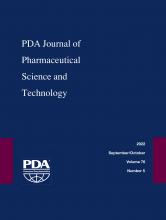Abstract
Maintaining container closure integrity (CCI) is challenging for vials that are packaged at room temperature and stored and/or transported at a colder temperature, such as −80°C. Cold temperatures can affect the sealing mechanisms of the package because of the glass transition temperature (−50°C to −70°C) of the rubber stopper used to seal the vial and the different coefficients of thermal expansion of each of the primary packaging components. Most CCI tests are conducted at room temperature and detect leaks from permanent defects that always exist under all storage conditions. However, previous research shows that temporary leaks that develop during cold storage can reseal when the vials are brought back up to room temperature and, therefore, can no longer be detected. The following study demonstrates two methods for CCI testing that can be performed with product-filled, frozen vials, packaged with unmodified headspace conditions using carbon dioxide ingress as a leak indicator. The two methods utilize different gas flow depending on the storage conditions. The first method generates effusive flow through a leaking defect, whereas the second generates diffusive flow. Experimental data revealed the effusive procedure detected laser-drilled defects ≥2 µm in empty glass vials and microwire defects in empty glass and plastic vials with effective defect sizes ≥0.4 and 0.6 µm, respectively. The diffusive procedure detected laser-drilled defects ≥2 µm in empty glass vials and microwire defects in empty glass and plastic vials with effective defect sizes ≥ 0.8 and 2.6 µm, respectively. Liquid product interactions with the defect as well as length of the storage period were also explored.
- Container closure integrity
- Headspace gas analysis
- Deep cold storage
- Frozen product
- −80°C storage
- Frequency modulation spectroscopy
- Method development
- USP 1207
- Carbon dioxide
- © PDA, Inc. 2022
PDA members receive access to all articles published in the current year and previous volume year. Institutional subscribers received access to all content. Log in below to receive access to this article if you are either of these.
If you are neither or you are a PDA member trying to access an article outside of your membership license, then you must purchase access to this article (below). If you do not have a username or password for JPST, you will be required to create an account prior to purchasing.
Full issue PDFs are for PDA members only.
Note to pda.org users
The PDA and PDA bookstore websites (www.pda.org and www.pda.org/bookstore) are separate websites from the PDA JPST website. When you first join PDA, your initial UserID and Password are sent to HighWirePress to create your PDA JPST account. Subsequent UserrID and Password changes required at the PDA websites will not pass on to PDA JPST and vice versa. If you forget your PDA JPST UserID and/or Password, you can request help to retrieve UserID and reset Password below.






